|
Events convened on Wednesday,
15 December 2004
|
|
The Climate Group: Global leaders for
climate solutions
Presented by the Climate Group
|
|
|
|
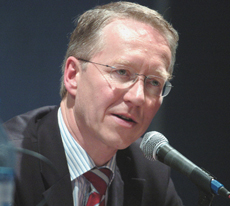 |
|
Werner Schnappauf, Bavarian
Environment Minister, presented the
Bavarian Climate Alliance, and said
Bavaria intends to launch climate
partnerships with other regions in the
world |
|
Mark Kenber, Climate Group, said his
organization was launched by UK
Prime Minister Tony Blair in April
2004, and forms a coalition of
leaders in carbon emissions
reductions, including corporations,
cities, federal States and central
governments.
Stéphane Dion, Canada’s Minister of
the Environment, presented Canada’s
response to the Kyoto Protocol and
perspectives for post-Kyoto schemes,
noting that Canada has the most
difficult target under the Protocol
and its major trading partner
decided not to participate. He said
the Government issued the Climate
Change Plan for Canada in November
2002, addressing emissions
reductions, technology development,
public education, and science and
adaptation, noting that Canada has
allocated more than CAN$3.7 billion
to address climate change. He
highlighted critical considerations
in addressing climate change,
including participation of all
Parties to the UNFCCC, realistic
short- and long-term goals,
promotion of technology development
and transfer, and activities to
address impacts and adaptation.
Minister Dion underscored Canada’s
commitment to
|
|
Jim Walker, Climate
Group, discussed
findings of the
report “Carbon down,
profits up,” which
provides examples of
profitable carbon
reductions achieved
by members of the
Carbon Group. He
emphasized that
several companies
managed to reduce
their carbon
emissions by more
than 60% in recent
years, including
IBM, which managed
to reduce its carbon
emissions by 65%
from 1990 levels,
resulting in total
savings of US$ 791
million.
Werner Schnappauf,
Bavarian Environment
Minister, said
climate change is
the biggest
ecological challenge
of the 21st century,
and stressed that it
has clear economic
implications. He
noted that 98% of
damages covered by
the world’s largest
reinsurance company,
MunichRe, in 2003
are climate-related.
He called for a
global strategy on
emissions reductions
that goes beyond
Kyoto targets, and
said Bavaria intends
to set an example by
achieving a 10%
emissions reduction
target for 2010
against the 2000
base year.
In a video address,
Otto Steinmetz,
Dresdner Bank, said
his organization
joined the Climate
Group because it is
committed to being a
leader in developing
and implementing
tools that address
global climate
change. He noted
that his company
provides products in
the field of weather
derivatives and
emissions trading.
Sascha Lafeld,
Dresdner Bank, spoke
on climate change
and corporate
sustainability at
the Allianz Group
and Dresdner Bank,
noting that
sustainability is a
high priority issue
for the Allianz
Group. He emphasized
that their climate
change activities
focus on emissions
trading, but also
include financing of
renewable energies
and conducting
research.
Discussion: A
participant asked
how other members of
the business
community could be
motivated for
action. Lafeld
responded that
identifying economic
opportunities
related to climate
change is the best
way to engage the
private sector.
|
|
|
Is climate change dangerous to human
health
Presented by the the World Health
Organization (WHO), the International
Society of Doctors for the Environment (ISDE)
and Climate Action Network (CAN)-Europe
|
|
|
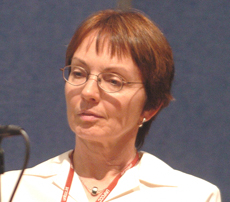 |
|
Kristie Ebi, Consultant, stressed
the need to maintain sustained
commitment to adapting the health sector
to climate change, noting that health
risks and their drivers change over time |
|
Bettina Menne, WHO,
highlighted the 2004
Budapest Ministerial
Declaration, in
which several
European ministers
of health and the
environment
recognize the need
for intervention
measures, such as
early warning
systems, to reduce
the burden of
climate change
impacts. She
proposed activities
to consider human
health within the
UNFCCC framework.
Noting that death
tolls and diseases
related to climate
change will double
by 2020, Carlos
Corvalan, WHO,
stressed the need
for the health
sector to consider
climate change as an
additional factor to
existing causes of
diseases, and
integrate health
with other sectors.
Karla Schoeters,
CAN-Europe,
highlighted the link
between climate
change and health,
noting the health
impacts of air
pollution resulting
from the use of
fossil fuels.
Lilian Corra, ISDE,
reviewed the impacts
of climate change on
children’s
health, stressing
that children are
among the most
vulnerable groups,
and that more than
30% of children’s
diseases are caused
by environmental
factors. |
Peter Hoeppe, Munich
Re, stressed the
impacts of climate
change on the
reinsurance sector,
noting that half of
the fatalities
worldwide are caused
by
atmospheric-related
events and that the
number is
increasing. He
explained how
climate change
affects, inter alia,
health, outdoor
activities and food
safety, and stressed
the need for
adaptation and
mitigation measures.
Carlo Jaeger,
Potsdam Institute
for Climate Impact
Research, discussed
regional aspects of
climate change and
human health. He
noted discrepancies
in the ability of
countries within the
same region to cope
with the effects of
extreme weather
events, said case
studies in Africa
show that climate
change will
increasingly hit
regions where
poverty is the
underlying cause of
vulnerability, and
stressed the need
for new types of
insurance and
institutions.
Saleemul Huq,
International
Institute for
Environment and
Development,
outlined
Bangladesh’s
experience in coping
with “normal”
floods, but stressed
the lack of capacity
to cope with extreme
events. He
underscored the need
to assist affected
countries’
institutions in
building their
coping capacities,
and facilitate
South-South
knowledge sharing.
Kristie Ebi,
Consultant, reviewed
how the public
health sector can
adapt to climate
change, stressing
the need for a risk
assessment-based
approach, a
sustained commitment
to adaptation, an
understanding of
multiple and
interacting
determinants of
disease,
surveillance and
early warning
systems, and inter-sectoral
coordination and
collaboration. She
stressed that
interventions must
be tailored to local
situations to be
effective.
|
|
|
How to make the UNFCCC carbon neutral?
Presented by the UNFCCC Secretariat
|
|
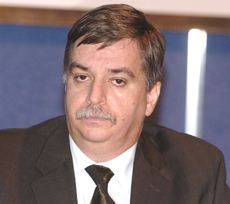 |
|
Iulian Florin Vladu, UNFCCC
Secretariat, said the Secretariat’s goal
is to apply the scheme for offsetting
carbon emissions at COP-11 |
|
Wanna Tanunchaiwatana, UNFCCC
Secretariat, stated that the main
aim in making the UNFCCC Secretariat
carbon neutral is to raise public
awareness on the issue.
Iulian Florin Vladu, UNFCCC
Secretariat, explained that the
first step in making the Secretariat
carbon neutral is to define how much
carbon is emitted, the second is to
offset the emissions by mitigation
activities, and the third is to
communicate results to stakeholders.
Emanuela Menichetti, Kyoto Club
Italy, described the methodology
used for, and results of, carbon
dioxide emissions calculations for
the 9th meeting of the Conference of
the Parties (COP), held in 2003, in
Milan, Italy. She said the final
figure was 7000 tons of carbon
dioxide, and indicated that 8000
tons of emission reductions had been
purchased from a biomass project in
Hungary to offset these emissions. |
|
Holger Liptow, Deutsche
Gesellschaft für Technische
Zusammenarbeit (GTZ),
outlined measures to offset
carbon emissions by GTZ’s
head office, including
purchasing green energy,
renovating office buildings,
encouraging employees not to
commute by car, and using
video conferences to reduce
travels. He said GTZ also
aims to purchase carbon
credits from a Gold Standard
Clean Development Mechanism
(CDM) project, noting that
the idea had been launched
in 2002, with the first
carbon credits expected in
2006.
Jonathan Pershing, World
Resources Institute (WRI),
explained that the WRI has
developed step-by-step
guidance regarding carbon
emissions from offices. He
said offsetting options
include changing practices
and purchasing carbon
credits.
Manfred Treber, Germanwatch,
said the “atmosfair”
methodology was developed to
calculate the global warming
impact of the aviation
sector, noting that it aims
to be both simple and
maintain integrity by taking
into account the radiative
forcing index based on the
1999 Intergovernmental Panel
on Climate Change (IPCC)’s
report on Aviation and
Global Atmosphere.
|
|
The EU emissions trading system and the
linking directive: What will it deliver?
Presented by the International Emissions
Trading Association (IETA)
|
|
 |
|
Chris McDermott, Environment
Canada, indicated that linking emissions
trading systems aims to further
institutionalize the Marrakesh
agreement, minimize transaction costs,
and provide for equitable access to
markets |
|
Damian Meadows, European Commission,
explained how the EU Emissions
Trading Directive applies to five
major energy-intensive sectors, and
said it will begin with a three-year
mandatory start-up phase from
2005-2007, followed by five-year
allocation periods. He outlined
linkages between the EU Emissions
Trading Scheme (EU ETS) and the
international climate agenda,
explaining that Article 25 of the
Directive allows trading with other
emissions trading systems, while the
Linking Directive incorporates Joint
Implementation (JI) and CDM credits
in the EU scheme.
Chris McDermott, Environment Canada,
noted that Canada has a relatively
small carbon market, and identified
the need for a more liquid emissions
trading market and an enabling
environment for multinational
participation. Indicating that the
Kyoto Protocol provides 95% of the
institutional framework for linking
emissions trading markets, he
stressed that bilateral agreements
should be limited to filling the
gaps. He said differences in
emissions trading systems across
countries should not impede linking.
Hiroshi Yamagata, Japan’s Ministry
of Economy Trade, and Industry,
indicated that Japan’s Climate
Change Program adopted in 2002 aims
to achieve a 6% reduction from the
1990 base year, through cooperation
between government and business
sectors.
|
|
 |
|
Hugh Porteous, Alcan, agreed that
domestic emissions trading systems need
not be identical to allow for the
linking of markets, but stressed the
need to address cost disparities in
allowances |
|
Hugh Porteous, Alcan, noted that
Alcan expects to be a net purchaser
of allowances in both Canada and the
EU, and stressed the value of
international sectoral commitments
to mitigating climate change, such
as investment in best available
technologies, and research and
development. He noted that linking
emissions trading systems is
essential, but inadequate in that it
sustains the inequities and
distortions inherent in the Kyoto
Protocol.
Bill Kyte, UK Emissions Trading
Group, indicated that emissions
trading systems can be either
formally linked, entailing direct
bidirectional transfer, mutual
recognition, equivalency and
simplicity, or informally linked,
entailing indirect unidirectional
transfer, no mutual recognition,
inequivalency and complexity. Noting
that there is no such thing as a
closed system, he stressed the need
to keep links simple in order to
facilitate business participation
and avoid “back door” commercial
linkages.
Thomas Jacob, DuPont, stressed that
linking the EU ETS with the CDM
process is crucial to ensuring that
the CDM delivers. Noting that the EU
is evolving as the hub of emissions
trading systems initiatives, he
anticipated that all major players
will be involved in the long term,
including the US.
|
Discussion: A participant indicated
that Norway had passed legislation
on emissions trading and expects to
be participating in the EU ETS
during the first period.
|
|
Finance for carbon solutions: The CDM
from the financial sector perspective
Presented by the Insurance Initiative
and UNEP
|
|
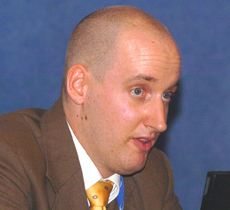 |
|
Sascha Lafeld, 3C climate change
consulting, said CDM projects entail
three basic categories of risks, namely
conventional project risks, political
risks in host countries, and risks
specific to the generation and sale of
CERs |
|
Thomas Loster, Munich Re, noted that
losses from climate change are
increasing, highlighted the key role
of the financial sector as a service
provider in the CDM process, and
stressed the role of public-private
partnerships in engaging all actors.
Sascha Lafeld, 3C climate change
consulting, said many Annex I
countries will face serious
compliance problems during the first
commitment period, which will create
a high demand for certified
emissions reductions (CERs). He
noted that investment is deterred by
the complexity of the CDM process,
the long timeframe for developing
CDM projects, and the lack of
institutional capacity in both host
and buyer countries. He stressed the
need to rethink additionality, and
recommended simplification and
standardization of the CDM process
and the provision of clear guidance
on the CDM regulation beyond 2012.
Charles Cormier, World Bank,
explained that his organization
seeks to catalyze the CDM market,
primarily by securing underlying
funding. He outlined a number of
obstacles to attracting investors,
including
regulatory uncertainty, high
transaction costs, and sovereign
risks. He indicated that the World
Bank seeks to improve the
bankability of projects, provide a
revenue stream, and manage
regulatory and financial risks. |
|
Rodrigo Sales, Baker and McKenzie,
outlined key elements of early CDM
contract negotiation, including
establishing the product to be sold,
legal titles over CERs, warranties
and indemnities, and provisions
dealing with breach of contract and
termination. He stressed the need to
assign risk in contracts, including
political and sovereign risks
particular to the host country.
María Szauer, Andean Corporation of
Promotion (CAF), identified
substantial growth in the carbon
market over the last two years,
noting that in 2003 and 2004, 51% of
CERs came from Asia and 27% from
Latin America and the Caribbean.
Hernan Carlino, Argentina’s
Secretariat of Environment and
Sustainable Development, outlined
plans to establish an Argentine
Carbon Fund to finance small and
medium CDM projects, noting that the
aim is to attract national and
international public and private
funding. He stressed that the fund
would help to reduce risk associated
with CDM project activities and
reduce transaction costs.
Klaus Töpfer, UNEP Executive
Director, stressed that increased
carbon dioxide concentrations have
international environmental impacts,
and indicated that this represents a
valuable opportunity to employ
international market instruments in
controling emissions. |
|
Adaptation in OECD countries
Presented by the Organization for
Economic Cooperation and Development
(OECD)
|
|
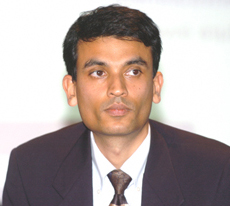 |
|
Shardul Agrawala, OECD, noted
that the largest temperature increases
since 1975 have occurred in Northern
latitudes, which makes the need for
adaptation in OECD countries
particularly pressing |
|
Kiyo Akasaka, OECD, said various
regions are already experiencing
climate change impacts, and stressed
that vulnerability is growing in
both OECD and developing countries.
Shardul Agrawala, OECD, reviewed
OECD’s work on assessing the
benefits of climate policies and
mainstreaming adaptation in
development planning. He said while
climate impacts have implications
for development on multiple
time-scales, they currently receive
little attention in development
planning.
Judy Lawrence, New Zealand’s
Ministry of the Environment,
reviewed New Zealand’s
adaptation-related legislation and
policies, and described a policy
cycle involving data generation,
risk assessment, mainstreaming
adaptation, monitoring and
evaluation, awareness raising, and
capacity building.
Marc Gillet, France’s Ministry of
Ecology and Sustainable Development,
gave examples of climate change
effects in France, and listed his
country’s adaptation research
activities and policy measures. |
|
Heikki Granholm, Finland’s Ministry
of Agriculture and Forestry, said
Finland’s national adaptation
strategy relies on modeling
socioeconomic scenarios and trends
in natural systems, and predicting
climate change impacts on
macroeconomic variables for the
2005-2080 period. He stressed the
need for more research, long-term
investments, short-term measures to
address variability, and win-win
solutions.
Andrew Deacon, UK Department for
Environment, Food and Rural Affairs,
said the UK approach embraces the
precautionary principle and makes
good business sense, since it avoids
future costs by reducing
vulnerability. He listed policy
examples, including allowances for
climate change in coastal
management, 25-year water management
plans, and programs on awareness
raising regarding summer health
problems.
Greg Picker, Australia’s Greenhouse
Office, discussed Australia’s
vulnerability to climate impacts,
listed national policies on water
management, and described
Australia’s efforts to develop
regional impact scenarios and
vulnerability assessments.
Discussion: Lawrence suggested that
differences in national
circumstances may preclude
standardization of adaptation
strategies. Granholm noted the
absence of reliable methodologies
for estimating the cost adaptation.
Picker said OECD and other
organizations have a role in
capacity building for data
generation and economic planning. |
|
Global warming and human rights: The
case of the Arctic
Presented by the Center for
International Environmental Law (CIEL)
|
|
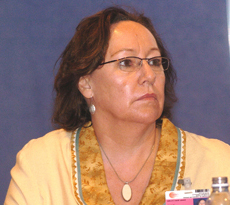 |
|
Sheila Watt-Cloutier, Inuit
Circumpolar Conference, said persistent
organic pollutants will be re-released
in the Arctic because of the melting of
ice induced by climate change |
|
Klaus Töpfer, UNEP Executive
Director, emphasized that the Arctic
represents an early warning system
for global environmental problems
such as global warming and pollution
from persistent organic pollutants,
and said developments in the Arctic
must be carefully examined. He noted
that the Inuit and other Arctic
indigenous peoples play an important
role in stimulating action on
environmental problems. He said
adaptation to climate change is
important, but stressed that
mitigation should be prioritized.
Sheila Watt-Cloutier, Inuit
Circumpolar Conference, said warming
in the Arctic is predicted to
increase at twice the global average
rate, and indicated that the
threshold of dangerous anthropogenic
interference defined in UNFCCC
Article 2 (Objective) has already
been reached in the Arctic. She
recounted changes already
experienced in the Arctic, including
permafrost melting, erosion,
infrastructure damage, longer
ice-free seasons, new species, and
deteriorating animal health. She
said accidents are increasing as
fast-melting glaciers make sea ice
unpredictable. She
explained that these changes result
in destructive social behavior in
Inuit communities, and urged radical
thinking within the UNFCCC framework
to preserve the Inuit culture. Watt-Cloutier
called for a comprehensive Arctic
monitoring program within the UNFCCC
to gather information from the
Arctic early warning system. She
stressed the urgent need for action,
and said countries must exceed their
Kyoto Protocol commitments. She
noted that the Inter-American
Commission on Human Rights has
recognized indigenous peoples’ right
to a healthy and safe environment as
integral to their right to life, and
indicated that the Inuit will
petition the Commission concerning
the impacts of climate change. |
Discussion: Watt-Cloutier explained
that the desired outcome of the
petition would be a Declaration
recognizing that climate change
violates the human rights of the
Inuit people. |
Longer term climate change frameworks –
regional and national business views
Presented by the International Chamber
of Commerce (ICC)
|
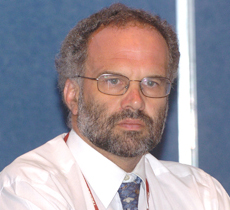 |
|
Nick Campbell, ICC Task Force on
Climate Change, described the challenge
of agreeing a long-term post-2012
climate regime as a major theme for
discussion at COP-10 |
|
Björn Stigson, World Business
Council for Sustainable Development,
described the development of a
common view on the way forward for
the post-2012 climate regime as the
key challenge for business and
governments.
Richard Smith, Nuclear Energy
Institute, argued that any plausible
program to cap global carbon
concentrations requires a nuclear
component as part of the mix of zero
carbon technologies capable of
delivering an average emission rate
of 0.2 kilograms of carbon per
kilowatt hour.
Kevin Fay, International Climate
Change Partnership, called for a
long-term objective to generate a
technology revolution, avoid
premature retirement of capital
stock, and provide clarity on
long-term goals.
Fiona Wain, Environment Business
Australia, underlined the need for
immediate deep cuts in emissions.
She added that the costs of
adaptation should be presented
alongside the costs of abatement and
mitigation, noting that adaptation
is not a low cost option. |
|
|
Masayuki Sasanouchi, Keidanren
industry association, described
Japanese industry’s objectives for a
future global climate framework,
including fundamental reform of the
CDM, development and diffusion of
technologies, and adoption of a
sector-specific approach.
Nick Campbell, ICC and European
Employers’ Federation, described
industry support in Europe for the
region’s leadership role in the
climate regime, and noted industry’s
apprehension regarding adoption of
new targets by the EU.
Discussion: Participants noted the
need to clarify market signals on
externalities, including adaptation
costs, and governments’ role in
underwriting risks associated with
breakthrough technologies for the
private sector, including the US
Government’s disputed role in
covering the nuclear industry.
Participants also considered:
competitiveness and equity;
involvement of US multinational
corporations in the current climate
regime, including emissions trading;
carbon intensity targets; and the
participation of developing
countries in a future regime. |
|
Next steps for CDM activities: Gaps and
ways to overcome them
Presented by the Institute for Global
Environmental Strategies (IGES), Japan’s
Overseas Environmental Cooperation
Center (OECC), and the Global
Environment Center Foundation (GEC)
|
|
Akio Morishima, IGES Chair, noted
close collaboration between IGES,
OECC and GEC regarding the Clean
Development Mechanism (CDM), and
expressed hope that the side event
would allow an exchange of
information and experiences on CDM
as a way to identify and develop
next steps.
Osamu Mizuno, Japan’s Office of
International Strategy on Climate
Change, presented an overview of
Japan’s work on capacity-building
activities for the CDM and Joint
Implementation (JI). He reported
that 12 CDM/JI projects had been
approved, and identified the need
for further consideration of
relevant information, capacity
building and next steps.
Shinichi Iioka, IGES, reported on
the CDM/JI Integrated Capacity
Strengthening Programme undertaken
by Japan’s Ministry of Environment.
He highlighted issues and barriers
identified, including weaknesses in
local institutional arrangements, a
lack of consensus on national
approval procedures, insufficient
accountability and transparency, and
the absence of national sustainable
development criteria and indicators
in some countries.
Joyceline Goco, Environmental
Management Bureau of the
Philippines, reported on the
Integrated Capacity Strengthening
Programme for CDM in her country.
Outlining the program, she said
expected outcomes include training
on CDM project development and
documentation, capacity building for
local stakeholders, identification
of specific projects for CDM
development, and a CDM country
guide.
Masako Ogawa, GEC, introduced GEC’s
work on CDM/JI, including
feasibility studies on landfill gas
and biomass projects. Identifying
lessons learnt, she highlighted the
need to develop the capacity of
project developers and host
countries.
Kazuhito Yamada, Pacific
Consultants, presented a CDM Manual
for project developers and policy
makers. Noting that the manual seeks
to explain complicated CDM
procedures, he said an updated
version may be published at COP-11.
Naoki Matsuo, Climate Experts,
discussed how to develop quality CDM
methodologies. Noting “bottlenecks”
in the CDM process due to low
quality methodologies and limited
understanding even within the CDM
Executive Board’s Methodologies
Panel, he drew attention to a
Methodologies Guidebook for the CDM.
Makoto Kato, OECC, described the
Kyoto Mechanism Information
Platform, which assists CDM/JI
stakeholders with their information
needs. He explained that this
initiative provides a useful
helpdesk for Japanese and
stakeholders from host countries.
Ernesto De Micheli, Patagoni CO2,
expressed appreciation for the
Information Platform, argued that
local financial institutions should
play an active role in CDM, and drew
attention to technology transfer.
Jan van Heeswijk, Asian Development
Bank, described the Bank’s CDM
Facility, noting that it was
established with the aim of
assisting developing countries in
accessing financial and technical
opportunities under the Kyoto
Protocol. On lessons learnt to date,
he highlighted, inter alia, an
overemphasis on technical issues,
the lack of focus on institutional
and financial aspects, and high
transaction costs.
IGES Board Member Taka Hiraishi
closed the event by noting that
there would be a post-meeting
follow-up by email, and that a
further event would likely be
convened at COP-11. |
|
 |
|
From left to right: Makoto Kato,
OECC, described the Kyoto Mechanism
Information Platform for assisting CDM/JI
stakeholders with their information
needs. Ernesto De Micheli,
Patagoni CO2, discussed his experience
with the Information Platform, while
Jan van Heeswijk, Director General
of the Asian Development Bank’s Regional
and Sustainable Development Department,
described the Bank’s CDM Facility |
|
|
The Kyoto train: Where do we go next?
Presented by IGES and The Energy and
Resources Institute (TERI)
|
|
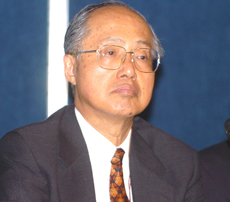 |
|
Akio Morishima highlighted IGES
recommendations for the future climate
policy regime, including cost caps,
carbon-intensity targets and unilateral
CDM projects |
|
Akio Morishima, IGES,
presented an IGES
publication on the
Kyoto Protocol and
future arrangements.
He said the Kyoto
Protocol is a good
basis for a future
policy regime, but
identified
shortcomings,
including its
short-term focus,
low emissions
reduction targets,
and lack of global
coverage. Morishima
highlighted
recommendations on
the need to: provide
incentives for
universal
participation, such
as resources for
adaptation and
technology transfer;
revise the CDM;
develop low-carbon
technologies;
establish
“unilateral CDM”
projects and
South-South CDM
mechanisms;
introduce cost caps
and carbon intensity
commitments; and
create non-binding
targets for
developing
countries.
Rajendra Pauchari,
IPCC, emphasized the
need to provide
compelling evidence
that the cost of
inaction would
exceed the cost of
action, and noted
major challenges in
assessing the
geophysical and
socioeconomic
aspects of climate
change.
Osamu Mizuno,
Japan’s Ministry of
the Environment,
introduced Japan’s
Environmental
Council’s interim
report on the
climate regime
beyond 2012. He
stressed the need
for a balance
between GHG
emissions and sink
capacity, achieve a
downward emissions
trend between
2020-2030, adopt a
precautionary
approach to
environmental risk
management, and
address equity
issues. Mizuno said
climate change
presents a valuable
opportunity to
create a mutually
beneficial cycle
between the
environment and the
economy. |
|
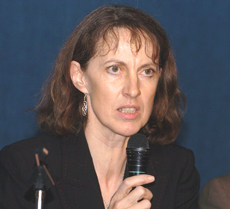 |
|
Jacqueline McGlade, European
Environment Agency, said the set of
European policy mechanisms is made
flexible enough to respond to constantly
evolving knowledge, noting that some
European areas used to be sinks and are
now sources of carbon |
|
In a panel
discussion, Michael
Zammit Cutajar,
former UNFCCC
Executive Secretary,
said the main
obstacle to a better
future is short-term
economic
defensiveness, and
stressed the need
for increased focus
on the cost of
inaction and
economic interests
in addressing
climate change.
Hironori Hamanaka,
IGES, noted that the
experience of Annex
I countries will
influence the future
regime, and
underscored the
importance of
sharing experiences,
promoting
multistakeholder
dialogues, and
providing concrete
incentives for
universal
participation.
Jacqueline McGlade,
European
Environmental
Agency, spoke on the
EU’s evolving set of
policy mechanisms,
and stressed the
need to provide
incentives for
industrial
realignment, develop
a firm knowledge
base for policy
making, build trust
across networks to
encourage
information sharing,
and focus public
discourse on the
multiple benefits of
mitigation efforts
for human health and
the energy sector.
Daniel Bodansky,
University of
Georgia, listed
building blocks for
a future regime,
including:
establishing
long-term goals;
linking targets and
trading, focusing on
development policy;
adopting a sectoral
approach; developing
technology; taking a
bottom-up approach;
linking emissions
trading markets; and
addressing
adaptation.
|
|
Chandrashekhar
Dasgupta, Teri,
advocated a
two-track strategy
to preserve the
basic structure of
the Kyoto Protocol,
while adding an
“optional protocol”
based on
non-negotiated and
non-binding
commitments. He
called for providing
incentives for
developing country
participation,
ensuring that CDM
measures comply with
host government
regulations,
developing
“unilateral” and
sectoral CDM
projects, and
simplifying CDM
methodology.
Cédric Philibert,
International Energy
Agency, advocated
transforming the
Kyoto Protocol by
retaining its
emissions trading
system and replacing
set binding targets
with non-binding
ones, integrating
targets with indices
related to economic
development, and
renegotiating the
CDM before 2012.
Jaycee Jai-chul Choi,
Korea’s Ministry of
Foreign Affairs and
Trade, called for
combining top-down
and bottom-up
approaches, creating
a global regime on
technology transfer,
providing incentives
for participation
and flexibility to
accommodate national
circumstances, and
developing an
“open-structure” CDM.
Yang Hongwei,
China’s Energy
Research Institute,
said socioeconomic
development should
be the basis for
mitigation policies,
and stressed the
need to promote the
development,
transfer, diffusion
and application of
new climate-friendly
technologies. |
|
|
|







